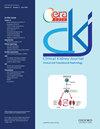Efficacy and safety of telitacicept, a BLyS/APRIL dual inhibitor, in the treatment of IgA nephropathy: a retrospective case-control study
IF 4.6
2区 医学
Q1 UROLOGY & NEPHROLOGY
引用次数: 0
Abstract
Background Telitacicept, a BLyS/APRIL dual-target fusion protein, has recently been used in autoimmune diseases. We assessed Telitacicept’ s efficacy and safety in IgA nephropathy (IgAN) patients. Methods This study included 42 IgAN patients who received Telitacicept treatment, forming the ‘whole Telitacicept group’. Among them, 20 patients who had not previously received corticosteroid (CS) therapy or immunosuppressive (IS) agents were categorized as the ‘newly treated Telitacicept subgroup’. Additionally, 28 patients who were selected to match historical controls received conventional IS (CS therapy with/without IS agents) therapy and were classified as the ‘conventional IS group’. Telitacicept was partially used in combination with conventional IS, including initial CS in different doses. Various indicators were compared at 4-week intervals up to 24 weeks among the three groups. Results After 24 weeks of treatment, the 24-hour proteinuria decreased from 1.70 [interquartile range (IQR), 1.05–2.58]g to 0.21 (0.39–0.13) g (P = 0.043) in the newly treated Telitacicept subgroup, from 1.78 (0.97–2.82) g to 0.44 (1.48–0.16) g (P = 0.001) in the conventional IS group, and from 1.07 (0.66–1.99) g to 0.26 (0.59–0.17) g (P = 0.028) in the whole Telitacicept group. The estimated glomerular filtration rate (eGFR) increased from (76.58 ± 30.26) ml/min/1.73m2 to (80.30 ± 26.76) ml/min/1.73m2 (P = 0.016) in the newly treated Telitacicept subgroup, from (72.73 ± 33.41) ml/min/1.73m2 to (84.08.10 ± 26.81) ml/min/1.73m2 (P = 0.011) in the conventional IS group, and from (70.10 ± 32.88) ml/min/1.73m2 to (71.21 ± 31.49) ml/min/1.73m2 (P = 0.065) in the whole Telitacicept group. During follow-up periods, the efficacy rates of the three groups did not show statistically significant differences, and no serious adverse events (SAEs) were observed. Conclusions Telitacicept may be a safe and effective treatment for IgAN, offering similar reductions in proteinuria and increases in eGFR as conventional IS therapy. After a 24-week follow-up, the incidence of adverse events (AEs) was lower for Telitacicept than for conventional IS therapy.泰利他赛(一种BLyS/APRIL双重抑制剂)治疗IgA肾病的疗效和安全性:一项回顾性病例对照研究
背景 Telitacicept 是一种 BLyS/APRIL 双靶点融合蛋白,最近被用于治疗自身免疫性疾病。我们评估了泰利他赛在 IgA 肾病(IgAN)患者中的疗效和安全性。方法 本研究纳入了 42 名接受泰利肝素治疗的 IgAN 患者,组成 "泰利肝素全组"。其中,20 名之前未接受过皮质类固醇(CS)治疗或免疫抑制剂(IS)治疗的患者被归入 "新接受泰利肝素治疗亚组"。此外,28 名被选中与历史对照组相匹配的患者接受了传统 IS(使用/不使用 IS 药物的 CS 治疗)治疗,被归入 "传统 IS 组"。泰利他赛普部分与传统IS疗法结合使用,包括不同剂量的初始CS。每隔 4 周对三组患者的各项指标进行比较,直至 24 周。结果 治疗 24 周后,新接受泰利肝素治疗的亚组 24 小时蛋白尿从 1.70 克[四分位距(IQR),1.05-2.58]克降至 0.21(0.39-0.13)克(P = 0.043),泰利肝素治疗的亚组 24 小时蛋白尿从 1.78 (0.97-2.82) g降至0.44 (1.48-0.16) g (P = 0.001),泰利昔普全组则从1.07 (0.66-1.99) g降至0.26 (0.59-0.17) g (P = 0.028)。在新治疗的泰利肝素亚组中,估计肾小球滤过率(eGFR)从(76.58 ± 30.26)毫升/分钟/1.73平方米增加到(80.30 ± 26.76)毫升/分钟/1.73平方米(P = 0.016),从(72.73 ± 33.41)ml/min/1.73m2升至(84.08.10 ± 26.81)ml/min/1.73m2(P = 0.011),泰利昔普全组从(70.10 ± 32.88)ml/min/1.73m2升至(71.21 ± 31.49)ml/min/1.73m2(P = 0.065)。在随访期间,三组的有效率在统计学上没有显著差异,也没有观察到严重不良事件(SAE)。结论 Telitacicept 可能是一种安全有效的 IgAN 治疗方法,与传统的 IS 治疗方法相比,它能减少蛋白尿,增加 eGFR。经过24周的随访,泰利肝素的不良事件(AEs)发生率低于常规IS疗法。
本文章由计算机程序翻译,如有差异,请以英文原文为准。
求助全文
约1分钟内获得全文
求助全文
来源期刊

Clinical Kidney Journal
Medicine-Transplantation
CiteScore
6.70
自引率
10.90%
发文量
242
审稿时长
8 weeks
期刊介绍:
About the Journal
Clinical Kidney Journal: Clinical and Translational Nephrology (ckj), an official journal of the ERA-EDTA (European Renal Association-European Dialysis and Transplant Association), is a fully open access, online only journal publishing bimonthly. The journal is an essential educational and training resource integrating clinical, translational and educational research into clinical practice. ckj aims to contribute to a translational research culture among nephrologists and kidney pathologists that helps close the gap between basic researchers and practicing clinicians and promote sorely needed innovation in the Nephrology field. All research articles in this journal have undergone peer review.
 求助内容:
求助内容: 应助结果提醒方式:
应助结果提醒方式:


